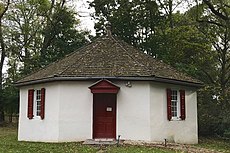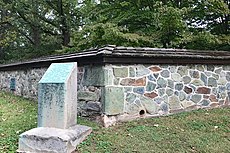Brandywine Battlefield Historic Site is a National Historical Landmark. The historic park is owned and operated by the Pennsylvania Historical and Museum Commission, on 52 acres (210,000 m2), near Chadds Ford, Delaware County, Pennsylvania in the United States. It is part of the site of the Battle of Brandywine fought on September 11, 1777, during the American Revolution. The Battle of Brandywine covered more than ten square miles, or 35,000 acres. However, the modern park only covers 50 acres which served primarily as the Continental encampment the two days prior to the battle. The battle was a decisive victory for the British and cleared a path directly to the rebel capital of Philadelphia. Brandywine Battlefield Park became a Pennsylvania State Park in 1949 and a National Historic Landmark in 1961.

Stony Brook Meeting House and Cemetery are historic Quaker sites located at the Stony Brook Settlement at the intersection of Princeton Pike/Mercer Road and Quaker Road in Princeton, New Jersey, United States. The first Europeans to settle in the Princeton area were six Quaker families who built their homes near the Stony Brook around 1696. In 1709 Benjamin Clark deeded nine and three-fifths acres in trust to Richard Stockton and others to establish a Friends meeting house and burial ground.

The Arch Street Friends Meeting House, at 320 Arch Street at the corner of 4th Street in the Old City neighborhood of Philadelphia, Pennsylvania, is a Meeting House of the Religious Society of Friends (Quakers). Built to reflect Friends’ testimonies of simplicity and equality, this building is little changed after more than two centuries of continuous use.

The Buckingham Friends Meeting House is a historic Quaker meeting house at 5684 Lower York Road in Buckingham Township, Bucks County, Pennsylvania. Built in 1768 in a "doubled" style, it is nationally significant as a model for many subsequent Friends Meeting Houses. It was declared a National Historic Landmark in 2003.

Newtown Friends Meetinghouse and Cemetery is a historic Quaker meetinghouse and cemetery in Newtown, Bucks County, Pennsylvania. It was built in 1817, and is a two-story, stuccoed stone building with a gable roof. It measures 60 feet by 40 feet, 6 bays long and 3 bays deep. A one-story porch was added in 1866, and the second floor was added in 1900. Also on the property is a contributing horse shed, built in 1819. Adjacent to the meeting house is the contributing cemetery.

Bradford Friends Meetinghouse, also known as Marshallton Meeting House, is a historic Quaker meeting house located at Marshallton in West Bradford Township, Chester County, Pennsylvania. It was built in 1764–1765, and is a one-story, stone structure with a gable roof. A porch was added to two sides of the building in the 19th century. The interior is divided into four rooms, rather than the customary two. Abraham Marshall, father of botanist Humphry Marshall was instrumental in the establishment of the meeting in the 1720s. The meeting originally met from 1722 to 1727 at the Marshall home, Derbydown Homestead, from 1722 to 1727.

Old Kennett Meetinghouse is a historic meeting house of the Religious Society of Friends or "Quakers" in Kennett Township near Chadds Ford, Pennsylvania.

Birmingham Orthodox Friends Meeting, also known as the Birmingham Orthodox Meeting House, is a historic Quaker meetinghouse in Birmingham Township, Chester County, Pennsylvania that was built in 1845 as a result of the Hicksite-Orthodox split in the Society of Friends. The members of the Birmingham Friends Meetinghouse, a few hundred yards north, joined the Hicksite branch of the Quaker movement, as was common among farmers in Chester and Delaware Counties. That meetinghouse was the site of fighting during the Battle of Brandywine in 1777, and is listed separately on the National Register of Historic Places.
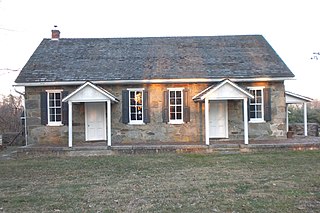
Parkersville Friends Meetinghouse, also known as Kennett Preparative Meeting of Friends, is a historic Quaker meeting house located in Pennsbury Township, Chester County, Pennsylvania. It was built in 1830, and rebuilt in 1917 after a fire. It is a one-story, stone building with a gable roof.

Catawissa Friends Meetinghouse is a historic Quaker meetinghouse at South and 3rd Streets in Catawissa, Columbia County, Pennsylvania. It was built about 1789, and is a one-story log building on a stone foundation. It measures 30 feet by 27 feet, 6 inches.

Chichester Friends Meetinghouse is a historic Quaker meeting house at 611 Meetinghouse Road near Boothwyn, in Upper Chichester Township, Delaware County, Pennsylvania. This area, near Chester, was one of the earliest areas settled by Quakers in Pennsylvania. The meetinghouse, first built in 1688, then rebuilt after a fire in 1769, reflects this early Quaker heritage. The building was added to the National Register of Historic Places in 1973.

Concord Friends Meetinghouse is a historic meeting house on Old Concord Road in Concordville, Delaware County, Pennsylvania. The meeting was first organized sometime before 1697, as the sixth Quaker meeting in what was then Chester County. In 1697 the meeting leased its current location for "one peppercorn yearly forever" from John Mendenhall. A log structure was built in 1710. The current brick edifice structure was built in 1728. After a fire which completely destroyed the interior, the meetinghouse was rebuilt and enlarged in 1788. During the Battle of Brandywine on September 11, 1777, which was fought a few miles to the west, wounded American soldiers took refuge in the meetinghouse.

Radnor Friends Meetinghouse is a historic Quaker meeting house on Sproul and Conestoga Roads in Radnor Township, Delaware County, Pennsylvania.

Plymouth Friends Meetinghouse is a historic Quaker meeting house located at the corner of Germantown Pike and Butler Pike in Plymouth Meeting, Montgomery County, Pennsylvania. It is part of the Plymouth Meeting Historic District, and was added to the National Register of Historic Places in 1971.
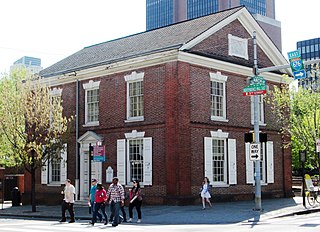
The Free Quaker Meetinghouse is a historic Free Quaker meeting house at the southeast corner of 5th and Arch Streets in the Independence National Historical Park in Philadelphia, Pennsylvania. It was built in 1783, and is a plain 2 1⁄2-story brick building with a gable roof. The second floor was added in 1788. The building was moved about 30 feet to its present site in 1961, to allow for the widening of Fifth Street.

The Chads House, which was built by John Wyeth Jr. for John Chads, is located in Chadds Ford, Delaware County, Pennsylvania. The house was built after 1712 and was added to the National Register of Historic Places on March 11, 1971. John Chad's widow, Elizabeth, stayed in the house while it was in the line of fire during the Battle of Brandywine. The city of Chadds Ford relied on the spring ford on the property, and thus the city was named after John Chads.

Sodom Schoolhouse is a historic octagonal school in West Chillisquaque Township, Northumberland County, Pennsylvania, United States reportedly built about 1812, 1835, or 1836 and used until 1915. It is located in a rural area on Pennsylvania Route 45 near several Scotch-Irish communities: the "small group of houses" formerly known as Sodom, which was about a mile east of the hamlet of Montandon, and about 3 miles east of a small town, Lewisburg.
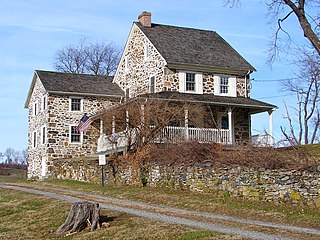
Okehocking Historic District, also known as the Okehocking Indian Land Grant Historic District, is a national historic district in Willistown Township, Chester County, Pennsylvania. It was listed on the National Register of Historic Places in 1993.
Friends meeting houses are places of worship for the Religious Society of Friends, or Quakers. A "meeting" is the equivalent of a church congregation, and a "meeting house" is the equivalent of a church building.

The Roaring Creek Friends Meeting House is a historic place of worship for members of the Religious Society of Friends, or Quakers, in rural Columbia County, Pennsylvania, near Numidia on Quaker Meeting House Road.



